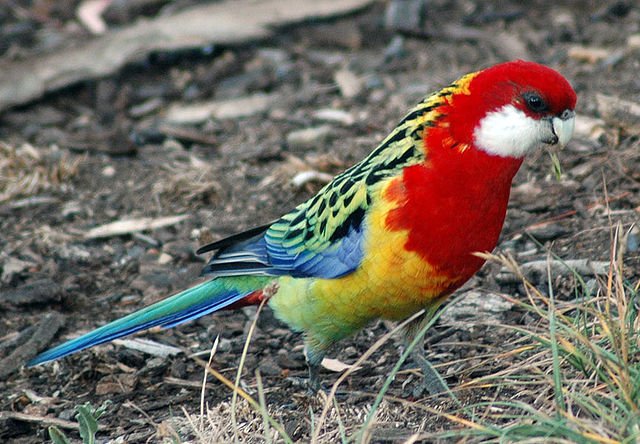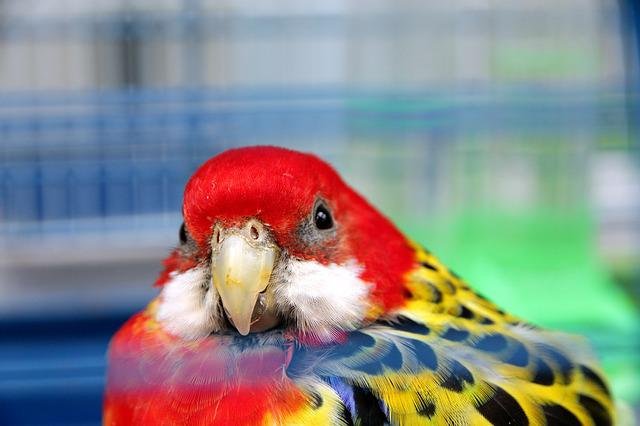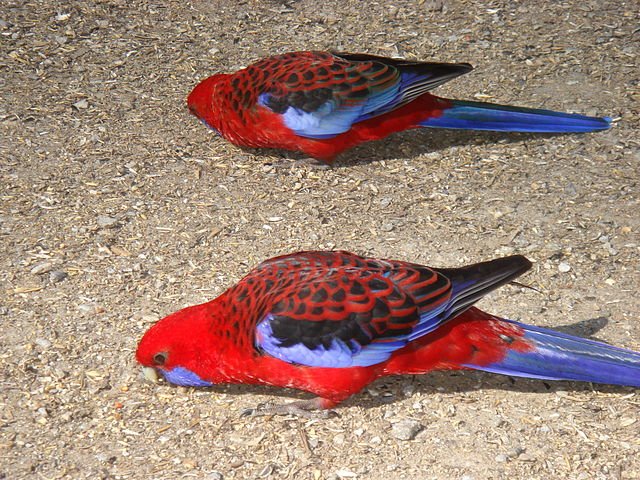Found in the open savanna and woodlands, Northern Rosella have got their name due to their wide presence in the northern region of Australia. They also happen to have exclusivity in this region, being the only rosella species found there. Inhabiting the Arnhem Land and the Gulf of Carpentaria along with the Kimberley, they can easily be spotted in a flock of 6-8 birds perched on a tree branch.
Northern Rosella Lifespan
In the wild, Northern Rosella lifespan averages around 15 years which happens to be quite less than they do while in captivity. Bound to eat as per availability, no one around to care for them, and getting eaten up by the dangerous wild animals are a few reasons that they hardly live beyond this age limit.
Northern Rosella lifespan in captivity averages more than courtesy the general and medical care by the owner and a balanced diet. They go on to live for roughly 20 years or sometimes, even beyond it.
Northern Rosella Colors
Northern Rosella happens to be differently colored than the rest of the rosella species. They have a dark head and mantle, of a little blackish tone. The rump and underparts along with the back are all of pale yellow color with black scallop markings. The wings are of black/blue-violet whereas the tail is blue-green. The legs are grey and the beak is white. The cheek patches are white and quite large. The eyes are dark-brown.
Northern Rosella Gender Differences
Northern rosellas are monomorphic and both the sexes are difficult to tell apart by simply looking at them. Though for the experts, a few minor differences are enough to identify the bird’s gender.
Northern Rosella Size
Size is the first physical difference used to tell both the sexes apart. Where the Northern males happen to be around 13 inches, their female counterparts are visibly smaller in size, roughly at 11 inches only.
Northern Rosella Weight
The Northern males are generally heavier than the females. Where males weigh around 110 grams, the females have an average weight of 90 grams.
Northern Rosella Wingspan
The wingspan can also help in roughly determining the gender of the bird. Northern males have a wingspan of about 17 inches against the females having only 15 inches wingspan.
Northern Rosella Underwing
Examining the underwing of Northern Rosellas for knowing their gender is very common. Whereas males have no underwing stripe, the females have a clear white underwing stripe.
Northern Rosella Plumage
Another common way of telling the gender of Northern rosella apart is by comparing the bird’s plumage. The males have a bright plumage against the females, that have a duller toned plumage along with occasional red spots.
Northern Rosella Breeding
To know about how Northern Rosellas breed, it is important to know about all the aspects involved, one by one, for a better clarity.
Northern Rosella Nesting Requirements
Northern Rosellas love to nest inside tree hollows, especially eucalyptus. The ideal tree cavity would be 1 meter deep and wide enough to offer them a snug fit. They line these cavities with wood dust. This keeps the area inside the nest cozy. When near the urban settlements, they select hollow posts or stumps a perfect nesting site.
For the cage dwellers, a special nesting box must be provided to encourage breeding behavior. This can be done by providing them a nest box that is neither too big for a snug-fit nor too small to lay eggs. This nest box can be attached to the dark and rear end of his daily cage as it would give them much-needed privacy during breeding. Line this nest box with wood dust or organic wood shavings to add warmth to it.
For the aviaries, one can hang a few hollow logs of varied sizes lined with wood dust. Let the pair choose their favorite nesting log. Remove all other once the pair zeroes in on any nest-log.
Northern Rosella Breeding Season
Northern rosellas are naturally inclined to breed during the rainy season. In most parts of the world, this time falls around September and ends by January. However, the months vary depending on the rainy months in various parts of the world.
Northern Rosella Breeding Behavior
A fun-loving and playful bird generally, Northern rosellas experience hormonal changes during the breeding season. This impacts their behavior with males getting overtly aggressive and territorial. The aggression is mainly directed towards the female for staying inside their cozy nest.
Northern Rosella Egg-Laying
The female Northern Rosellas lay a clutch every season. However, laying two clutches in a season isn’t uncommon in Northern Rosellas. Each clutch has 2-5 slightly glossy white eggs. The hen alone incubates the eggs for around 19 days. In the meantime, the male Northern takes care of the hen and performs all other household chores.
Once the young ones are hatched, both the male and the female Northern actively take part in the rearing of the young ones. The parents feed the young ones taking turns. The young ones fledge at around 7 weeks old, it takes them another 6-8 weeks to become completely independent.
Northern Rosella Diet
Northern rosella diet varies with his habitat. Their diet profile differs in the wild and captivity.
Northern Rosella Diet in the Wild
Fond of cypress, wattles and eucalyptus seeds in the wild, the diet of the Northern rosellas is quite diverse in the wild. They also love feeding on both nectar and seeds of white gum, fiber bark, fern-leaved grevillea, Darwin stringybark, and long-fruited bloodwood. Gorging on flowers and fruits of Darwin woollybutt, etc. Apart from all this variety, they don’t mind a few insects or their larvae throughout the day.

Northern Rosella Diet in Captivity
Northern Rosellas as pets are completely dependent on their owner for a healthy and balanced diet. And it becomes the duty of the owner to feed his bird a nutritious diet to keep the bird in his best health.
Seeds are a favorite of Northern Rosellas in captivity too. A mix of millets, sunflower, quinoa, oats, safflower can be served either soaked or sprouted. Serve them only a spoonful or two in a day as seeds are high in fat content and can cause obesity in them. Also, experts advise against feeding the market-made seed-mix as it contains added fat and artificial preservatives that can harm the bird’s health.
Fresh fruits are a treat for Northern Rosellas. And they love having a little of them all. Serve them mangoes, berries, pomegranates, strawberries, apples, pears, bananas, blueberries, pineapples. These should be freshly chopped, diced, sliced, or pureed and any fruit bowl that has lost its freshen after being kept uneaten for a few hours must be discarded.
Pellets are a must for Northern rosellas for a balanced nutrition profile. They should constitute around 50-70 % of the bird’s diet. Serve them pellets from a high-quality trusted brand. There are multiple options online and at pet stores. In case of any confusion, consult the vet for perfect advice.
Northern rosellas love their vegetables, especially green leafy ones. Collard greens, kale greens, kale, green beans, and watercress are his favorites. One can also add a few leaves of spinach or broccoli for fulfilling the bird’s daily calcium requirements. Additionally, they must be fed the dark-skinned vegetables since they are loaded with Vitamin A. Cut pumpkins, winter squash, or sweet potatoes in bite-sized pieces and add them to the bird’s feed.
Cuttlebones are a must to renew Northern rosella’s calcium reserves. They double up as a chewable toy for the bird and keep their beak in shape while the bird chews it. The best way is to hang the cuttlebone near one of the perches installed inside his cage for the bird to sit and chew on it.
For keeping the Northern rosella hydrated, freshwater is necessary. It also maintains the optimum body temperature of the bird. Make sure to keep a feeding bowl filled with water all the time inside the bird’s cage. The water must either be of drinkable quality as not to contain any impurities. For the hot and humid times, keep another bowl as a backup. Make sure to change the water of the bowl regularly to maintain the bird’s health and hygiene.
Summing Up
Northern Rosellas aren’t very popular as pets. They have been tagged as an aggressive and untalented bird for long. Like other birds, they lack talking or intellectual abilities. Contrary to the belief, they can entertain everyone around but in their unique ways. Owing to this, parrot lovers have recently grown an affection towards this little colorful canvas-kind of birds.. With a fairly large lifespan and fun-loving personality, they make great companion parrots. They neither are too shy to gel with nor too demanding to take up all your day. A little care and attention make this bird happy. And In return, the bird commits all his time and loyalty to the owner until the end of his life.
Featured Photo Credit :Summerdrought / CC BY-SA (https://creativecommons.org/licenses/by-sa/4.0)



